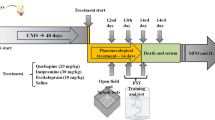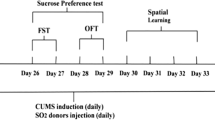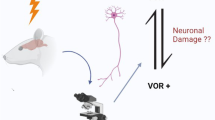Abstract
Rationale
A complex relationship exists among stressful situations, body's reaction to stress, and the onset of clinical depression. Chronic unpredictable stressors can produce a situation similar to clinical depression, and such animal models can be used for the preclinical evaluation of antidepressants. Many findings have shown that the levels of proinflammatory cytokines (e.g., TNF-α) and oxidative stress (increased lipid peroxidation, decreased glutathione levels, and endogenous antioxidant enzyme activities) are increased in patients with depression. Sesamol, a phenolic derivative with a methylenedioxy group, is a potent inhibitor of cytokine production as well as an antioxidant.
Objectives
The present study was designed to investigate the effect of sesamol on unpredictable chronic stress-induced behavioral and biochemical alterations in mice.
Methods
Animals were subjected to different stress paradigms daily for a period of 21 days to induce depressive-like behavior. The sucrose preference, immobility period, locomotor activity, memory acquisition, and retention were evaluated.
Results
Chronic treatment with sesamol significantly reversed the unpredictable chronic stress-induced behavioral (increased immobility period, reduced sucrose preference), biochemical (increased lipid peroxidation and nitrite levels; decreased glutathione levels, superoxide dismutase and catalase activities), and inflammation surge (serum TNF-α) in stressed mice.
Conclusion
The study revealed that sesamol exerted antidepressant-like effects in behavioral despair paradigm in chronically stressed mice, specifically by modulating central oxidative-nitrosative stress and inflammation.




Similar content being viewed by others
References
Ando K, Sako K, Takahashi M, Beppu M, Kikugawa K (2000) Increased band 3 protein aggregation and anti-band 3 binding of erythrocyte membranes on treatment with sesamol. Biol Pharm Bull 23:159–164
Barden N (2004) Implication of the hypothalamic–pituitary–adrenal axis in the physiopathology of depression. J Psychiatry Neurosci 29:185–193
Bekris S, Antoniou K, Daskas S, Papadopoulou-Daifoti Z (2005) Behavioural and neurochemical effects induced by chronic mild stress applied to two different rat strains. Behav Brain Res 161:45–59
Bhattacharya SK, Muruganandam AV (2003) Adaptogenic activity of Withania somnifera: an experimental study using a rat model of chronic stress. Pharmacol Biochem Behav 75:547–555
Bilici M, Efe H, Koroglu MA, Uydu HA, Bekaroglu M, Deger O (2001) Antioxidative enzyme activities and lipid peroxidation in major depression: alterations by antidepressant treatments. J Affect Disord 64:43–51
Budowski P (1950) Sesame oil. III. Antioxidant properties of sesamol. J Am Oil Chem Soc 27:264–267
Chavali SR, Utsunomiya T, Forse RA (2001) Increased survival after cecal ligation and puncture in mice consuming diets enriched with sesame seed oil. Crit Care Med 29:140–143
Chen H, Pandey GN, Dwivedi Y (2006) Hippocampal cell proliferation regulation by repeated stress and antidepressants. Neuroreport 17:863–867
Claiborne A (1985) Catalase activity. In: Greenwald RA (ed) Handbook of methods for oxygen radical research. CRC, Boca Raton, pp 283–284
Eren I, Nazroglu M, Demirdas A, Celik O, Uguz AC, Altunbasak A, Ozmen Uz E (2007) Venlafaxine modulates depression-induced oxidative stress in brain and medulla of rat. Neurochem Res 32:497–505
Esquifino AI, Cano P, Jimenez V, Reyes Toso CF, Cardinali DP (2004) Changes of prolactin regulatory mechanisms in aging: 24-h rhythms of serum prolactin and median eminence and adenohypophysial concentration of dopamine, serotonin, gamma-aminobutyric acid, taurine and somatostatin in young and aged rats. Exp Gerontol 39:45–52
Fontella FU, Siqueira IR, Vasconcellos APS, Tabajara AS, Netto CA, Dalmaz C (2005) Repeated restraint stress induces oxidative damage in rat hippocampus. Neurochem Res 30:105–111
Fukuda Y, Osawa T, Kawakishi S, Namiki M (1994) Chemistry of lignan antioxidants in sesame seed and oil. In: Food Phytochemicals for Cancer Prevention II. American Chemical Society, pp 264–274
Furay AR, Bruestle AE, Herman JP (2008) The role of the forebrain glucocorticoid receptor in acute and chronic stress. Endocrinology 149:5482–5490
Garcia R (2002) Stress, metaplasticity, and antidepressants. Curr Mol Med 2:629–638
Green LC, Wagner DA, Glogowski J, Skipper PL, Wishnok JS, Tannenbaum SR (1982) Analysis of nitrate, nitrite, and [15 N] nitrate in biological fluids. Anal Biochem 126:131–138
Henn FA, Vollmayr B (2005) Stress models of depression: forming genetically vulnerable strains. Neurosci Biobehav Rev 29:799–804
Hou RCW, Chen YS, Chen CH, Chen YH, Jeng KCG (2006) Protective effect of 1, 2, 4-benzenetriol on LPS-induced NO production by BV2 microglial cells. J Biomed Sci 13:89–99
Hsu DZ, Chen KT, Li YH, Chuang YC, Liu MY (2006) Sesamol delays mortality and attenuates hepatic injury after cecal ligation and puncture in rats: role of oxidative stress. Shock 25:528–532
Huang TL, Lee CT (2007) T-helper 1/T-helper 2 cytokine imbalance and clinical phenotypes of acute-phase major depression. Psychiatry Clin Neurosci 61:415–420
Ishikawa I, Kitamura H, Kimura K, Saito M (2001) Brain interleukin-1 is involved in blood interleukin-6 response to immobilization stress in rats. Jpn J Vet Res 49:19–25
Joca SRL, Guimaraes FS (2006) Inhibition of neuronal nitric oxide synthase in the rat hippocampus induces antidepressant-like effects. Psychopharmacology 185:298–305
Jollow DJ, Mitchell JR, Zampaglione N, Gillette JR (1974) Bromobenze induced liver necrosis: protective role of glutathione and evidence for 3, 4-bromobenzenoxide as the hepatotoxic metabolite. Pharmacology 11:151–169
Joshi R, Kumar MS, Satyamoorthy K, Unnikrisnan MK, Mukherjee T (2005) Free radical reactions and antioxidant activities of sesamol: pulse radiolytic and biochemical studies. J Agric Food Chem 53:2696–2703
Kalueff AV, Gallagher PS, Murphy DL (2006) Are serotonin transporter knockout mice ‘depressed’?: hypoactivity but no anhedonia. Neuroreport 17:1347–1351
Kanimozhi P, Prasad NR (2009) Antioxidant potential of sesamol and its role on radiation-induced DNA damage in whole-body irradiated Swiss albino mice. Environ Toxicol Pharmacol 28:192–197
Kapadia GJ, Azuine MA, Tokuda H, Takasaki M, Mukainaka T, Konoshima T, Nishino H (2002) Chemopreventive effect of resveratrol, sesamol, sesame oil and sunflower oil in the epstein-barr virus early antigen activation assay and the mouse skin two-stage carcinogenesis. Pharmacol Res 45:499–505
Katz RJ, Hersh S (1981) Amitriptyline and scopolamine in an animal model of depression. Neurosci Biobehav Rev 5:265–271
Katz RJ, Schmaltz K (1980) Dopaminergic involvement in attention. a novel animal model. Prog Neuropsychopharmacol Biol Psychiatry 4:585–590
Kaur IP, Saini A (2000) Sesamol exhibits antimutagenic activity against oxygen species mediated mutagenicity. Mutat Res 470:71–76
Kennedy SH (2006) A review of antidepressant treatments today. Eur Neuropsychopharmacol 16:S619–S623
Kennett GA, Chaouloff F, Marcou M, Curzon G (1986) Female rats are more vulnerable than males in an animal model of depression: the possible role of serotonin. Brain Res 382:416–421
Kioukia-Fougia N, Antoniou K, Bekris S, Liapi C, Christofidis I, Papadopoulou-Daifoti Z (2002) The effects of stress exposure on the hypothalamic-pituitary-adrenal axis, thymus, thyroid hormones and glucose levels. Prog Neuropsychopharmacol Biol Psychiatry 26:823–830
Kono Y (1978) Generation of superoxide radical during autoxidation of hydroxylamine and an assay for superoxide dismutase. Arch Biochem Biophys 186:189–195
Kuhad A, Chopra K (2008) Effect of sesamol on diabetes-associated cognitive decline in rats. Exp Brain Res 185:411–420
Kulkarni SK, Mehta AK (1985) Purine nucleoside-mediated immobility in mice: reversal by antidepressants. Psychopharmacology 85:460–463
Li Y, Ji YJ, Jiang H, Liu DX, Zhang Q, Fan SJ, Pan F (2009) Effects of unpredictable chronic stress on behavior and brain-derived neurotrophic factor expression in CA3 subfield and dentate gyrus of the hippocampus in different aged rats. Chin Med J (Engl) 122(13):1564–1569
Lin YH, Liu AH, Xu Y, Tie L, Yu HM, Li XJ (2005) Effect of chronic unpredictable mild stress on brain-pancreas relative protein in rat brain and pancreas. Behav Brain Res 165:63–71
Maes M, De Vos N, Pioli R, Demedts P, Wauters A, Neels H, Christophe A (2000) Lower serum vitamin E concentrations in major depression: another marker of lowered antioxidant defenses in that illness. J Affect Disord 58:241–246
Maes M, Yirmyia R, Noraberg J, Brene S, Hibbeln J, Perini G, Kubera M, Bob P, Lerer B, Maj M (2009) The inflammatory & neurodegenerative (I & ND) hypothesis of depression: leads for future research and new drug developments in depression. Metab Brain Dis 24:27–53
Maier SF (1984) Learned helplessness and animal models of depression. Prog Neuropsychopharmacol Biol Psychiatry 8:435–446
Michel TM, Frangou S, Thiemeyer D, Camara S, Jecel J, Nara K, Brunklaus A, Zoechling R, Riederer P (2007) Evidence for oxidative stress in the frontal cortex in patients with recurrent depressive disorder—a postmortem study. Psychiatry Res 151:145–150
Molina VA, Volosin M, Cancela L, Keller E, Murua VS, Basso AM (1990) Effect of chronic variable stress on monoamine receptors: influence of imipramine administration. Pharmacol Biochem Behav 35:335–340
Murua VS, Gomez RA, Andrea ME, Molina VA (1991) Shuttle-box deficits induced by chronic variable stress: reversal by imipramine administration. Pharmacol Biochem Behav 38:125–130
Nemeroff CB (2007) The burden of severe depression: a review of diagnostic challenges and treatment alternatives. J Psychiatr Res 41:189–206
Nestler EJ, Barrot M, DiLeone RJ, Eisch AJ, Gold SJ, Monteggia LM (2002) Neurobiology of depression. Neuron 34:13–25
Nguyen KT, Deak T, Owens SM, Kohno T, Fleshner M, Watkins LR, Maier SF (1998) Exposure to acute stress induces brain interleukin-1beta protein in the rat. J Neurosci 18:2239
Oliveira RM, Guimaraes FS, Deakin JF (2008) Expression of neuronal nitric oxide synthase in the hippocampal formation in affective disorders. Braz J Med Biol Res 41:333–41
Ohta S, Suzuki M, Sato N, Kamogawa A, Shinoda M (1994) Protective effects of sesamol and its related compounds on carbon tetrachloride induced liver injury in rats. Yakugaku Zasshi 114:901–910
Parihar VK, Prabhakar KR, Veerapur VP, Kumar MS, Reddy YR, Joshi R, Unnikrishnan MK, Rao CM (2006) Effect of sesamol on radiation-induced cytotoxicity in Swiss albino mice. Mutat Res 611:9–16
Percaccio CR, Engineer ND, Pruette AL, Pandya PK, Moucha R, Rathbun DL, Kilgard MP (2005) Environmental enrichment increases paired-pulse depression in rat auditory cortex. J Neurophysiol 94:3590
Prasad NR, Mahesh T, Menon VP, Jeevanram RK, Pugalendi KV (2005a) Photoprotective effect of sesamol on UVB-radiation induced oxidative stress in human blood lymphocytes in vitro. Environ Toxicol Pharmacol 20:1–5
Prasad NR, Menon VP, Vasudev V, Pugalendi KV (2005b) Radioprotective effect of sesamol on [gamma]-radiation induced DNA damage, lipid peroxidation and antioxidants levels in cultured human lymphocytes. Toxicology 209:225–235
Saletu-Zyhlarz GM, Anderer P, Arnold O, Saletu B (2003) Confirmation of the neurophysiologically predicted therapeutic effects of trazodone on its target symptoms depression, anxiety and insomnia by postmarketing clinical studies with a controlled-release formulation in depressed outpatients. Neuropsychobiology 48:194–208
Schechter LE, Ring RH, Beyer CE, Hughes ZA, Khawaja X, Malberg JE, Rosenzweig-Lipson S (2005) Innovative approaches for the development of antidepressant drugs: current and future strategies. NeuroRx 2:590–611
Schiepers OJG, Wichers MC, Maes M (2005) Cytokines and major depression. Prog Neuropsychopharmacol Biol Psychiatry 29:201–217
Schurr A, Livne A (1976) Differential inhibition of mitochondrial monoamine oxidase from brain by hashish components. Biochem Pharmacol 25:1201–1203
Shapira-Lichter I, Beilin B, Ofek K, Bessler H, Gruberger M, Shavit Y, Seror D, Grinevich G, Posner E, Reichenberg A (2008) Cytokines and cholinergic signals co-modulate surgical stress-induced changes in mood and memory. Brain Behav Immun 22:388–398
Sharma M, Gupta YK (2002) Chronic treatment with trans resveratrol prevents intracerebroventricular streptozotocin induced cognitive impairment and oxidative stress in rats. Life Sci 71:2489–2498
Sharma S, Kaur IP (2005) Development and evaluation of sesamol as an antiaging agent. Int J Dermatol 45:200–208
Soblosky JB, Thurmond JB (1986) Biochemical and behavioral correlates of chronic stress: effects of tricyclic antidepressants. Pharmacol Biochem Behav 24:1361–1368
Steptoe A, Hamer M, Chida Y (2007) The effects of acute psychological stress on circulating inflammatory factors in humans: a review and meta-analysis. Brain Behav Immun 21:901–912
Strauman TJ, Vieth AZ, Merrill KA, Kolden GG, Woods TE, Klein MH, Papadakis AA, Schneider KL, Kwapil L (2006) Self-system therapy as an intervention for self-regulatory dysfunction in depression: a randomized comparison with cognitive therapy. J Consult Clin Psychol 74:367–376
Strekalova T, Gorenkova N, Schunk E, Dolgov O, Bartsch D (2006) Selective effects of citalopram in a mouse model of stress-induced anhedonia with a control for chronic stress. Behav Pharmacol 17:271–287
Suzuki E, Yagi G, Nakaki T, Kanba S, Asai M (2001) Elevated plasma nitrate levels in depressive states. J Affect Disord 63:221–224
Thomson F, Craighead M (2008) Innovative approaches for the treatment of depression: targeting the HPA axis. Neurochem Res 33:691–707
Uchida M, Nakajin S, Toyoshima S, Shinoda M (1996) Antioxidative effect of sesamol and related compounds on lipid peroxidation. Biol Pharm Bull 19:623–626
Willner P (1991) Animal models as simulations of depression. Trends Pharmacol Sci 12:131–136
Willner P, Muscat R, Papp M (1992) Chronic mild stress-induced anhedonia: a realistic animal model of depression. Neurosci Biobehav Rev 16:525–534
Willner P, Towell A, Sampson D, Sophokleous S, Muscat R (1987) Reduction of sucrose preference by chronic unpredictable mild stress, and its restoration by a tricyclic antidepressant. Psychopharmacology 93:358–364
Wills ED (1965) Mechanisms of lipid peroxide formation in tissues role of metals and haematin proteins in the catalysis of the oxidation of unsaturated fatty acids. Biochim Biophys Acta 98:238–251
Author information
Authors and Affiliations
Corresponding author
Rights and permissions
About this article
Cite this article
Kumar, B., Kuhad, A. & Chopra, K. Neuropsychopharmacological effect of sesamol in unpredictable chronic mild stress model of depression: behavioral and biochemical evidences. Psychopharmacology 214, 819–828 (2011). https://doi.org/10.1007/s00213-010-2094-2
Received:
Accepted:
Published:
Issue Date:
DOI: https://doi.org/10.1007/s00213-010-2094-2




